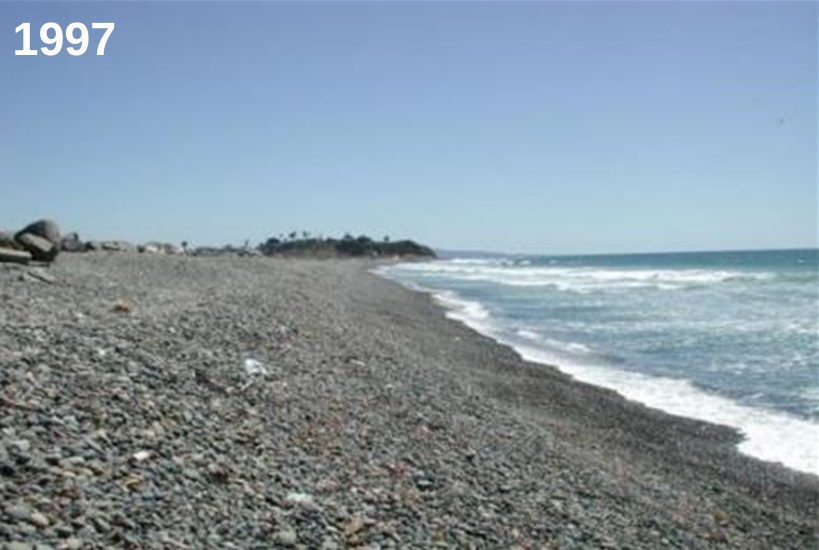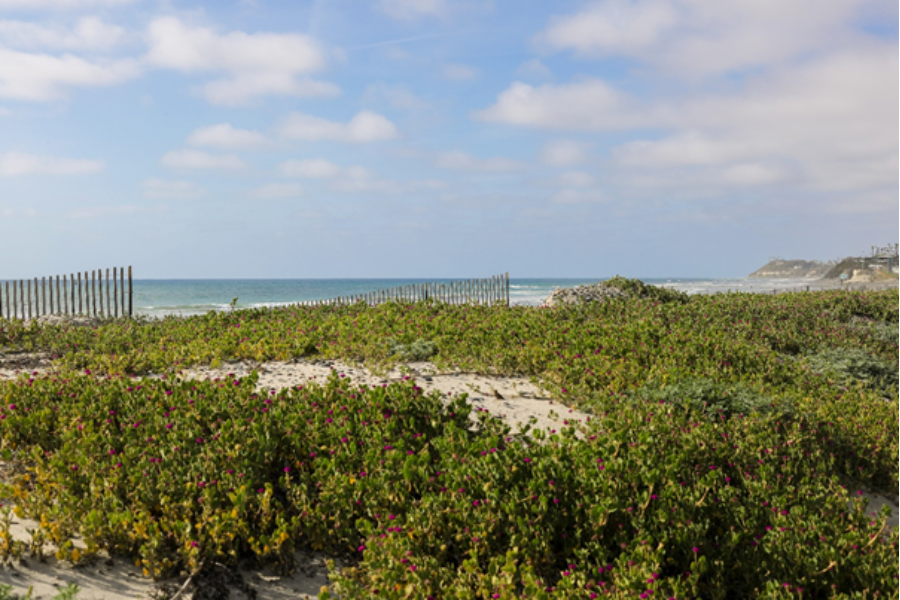The recent large storm and wave events that occurred in early January 2023 have again displayed the success of the Cardiff State Beach Living Shoreline Project. Without the existence of this engineered dune structure, there would almost certainly have been significant flooding and undermining of South Coast Highway 101 that would have required extensive and very expensive repairs. While a large amount of sand dune erosion occurred this year, the engineered aspects of the revetment wall are still fully intact. These significant storm and weather events demonstrate the Project’s resilience and effective adaptive coastal design.
Overview
The Cardiff State Beach Living Shoreline Project (Project) restored a historic dune system on top of buried rock revetment, intended to provide multiple engineering, environmental, and community benefits. The Project was grant funded by the California State Coastal Conservancy, Ocean Protection Council, U.S. Fish and Wildlife Service, and San Diego Association of Governments. It is managed by the City of Encinitas and California State Parks, in partnership with Nature Collective, University of California Los Angeles and Scripps Institute of Oceanography.
This innovative, nature-based Project addressed multiple issues along a low-lying area of the Cardiff coastline, including frequent flooding and erosion that impacted South Coast Highway 101, the prominence of cobble beaches that reduced coastal habitat and recreational beach use area, and previously poor beach access that was unsafe and not accessible for those with disabilities. The aim was to protect South Coast Highway 101 from damage, reduce flooding vulnerability, create coastal dune habitat, construct a pedestrian path along the beach, and beneficially reuse sand from annual San Elijo Lagoon dredging operations and other future projects containing excess high-quality beach sand.
Completed in May 2019, the Project beautifies, protects, and conserves habitat along this stretch of Cardiff State Beach, while providing new walking and biking opportunities that did not exist previously. The shoreline was rehabilitated with an engineered sand dune system that appears natural but provides the necessary rock revetment barrier underneath the dune system to provide South Coast Highway 101 with adequate protection from significant wave damage on this stretch of highway.
The Project serves as a pilot program to assess the feasibility of utilizing dune systems for shoreline protection at other coastal locations in California. After construction was complete, a five-year monitoring program was initiated to evaluate the performance of the dune, determine when maintenance and/or adaptation is needed, and to inform other coastal communities considering similar project designs.
Figures 1 and 2 show the condition of the Cardiff shoreline before the project was installed.



Coastal Resiliency Design
Construction of the Cardiff State Beach Living Shoreline Project began in October 2018. To protect South Coast Highway 101 from undermining and flooding, a buried rock revetment was designed and installed to act as a “last line of defense” in cases where the sand dune material is significantly eroded during major coastal storm events. The buried rock allows for the protection of the highway, even in the case of complete erosion of the sand dune material. Approximately 13,000 cubic yards of two- to four-ton rock was used to create the buried revetment wall through a combination of existing rock, reuse of rock from a nearby source, and purchased rock from a quarry. Excavated sand from the San Elijo Lagoon outlet was placed on top of the rock revetment to form the final dune structure.
After the revetment was placed, a cobble berm at the seaward toe of the dune was installed to act as the “first line of defense” for the sand dune. This berm was buried with variable dimensions and covered by dredged, imported sand. The cobble berm was designed to absorb incoming wave energy that breaks along the seaward toe of the dune structure.

The dune was constructed using existing and imported sand to form dune mounds 18 inches above the revetment and cobble berm, mimicking the shape of natural coastal dunes. After the sand was placed, the dune was planted with native vegetation, including Red Sand Verbena, Silver Burr Ragweed, Beach Sand Verbena, and Beach Evening-Primrose, to provide a root structure that would capture and hold sand material in place, while providing a natural look and habitat for native wildlife. Temporary sand fencing was installed throughout the project to help retain loose and blowing sand during wind events. As shown in figure 4, the planted zone is 30-foot wide and runs the entire dune reach on the landward side. The seaward 30-foot width is designed to act as a sacrificial erosion zone.


Current Performance
To date, the Cardiff State Beach Living Shoreline Project has achieved its objectives and proven itself to be an effective coastal resiliency measure through multiple large storm and wave events. There have been no significant instances of flooding or undermining of Coast Highway 101 since the Project’s installation. While the installed pedestrian pathways have experienced temporary disruptions after significant storm events, they have provided the much-needed coastal accessways to Cardiff Beach.
The coastal dune habitat planted as part of the project is flourishing. The vegetative cover has expanded its reach across the back and crest of dune and now has 50 percent coverage. While the preferred habitat for Western Snowy Plover appears to be at the nearby San Elijo Lagoon Ecological Reserve, the Living Shoreline is still proving to be a viable habitat and active foraging ground.

Throughout the post-project monitoring period, the dune has been found to be relatively stable with the majority of changes occurring at the sacrificial erosion zone at the toe of the dune. As these changes occur, adaptation measures are triggered in the restoration plan which allow for periodic maintenance of the dune system. An operation agreement is in place between the City of Encinitas, California State Parks and the Nature Collective that allows access to the project for maintenance and repairs.
To re-establish the sacrificial erosion zone after significant wave events, dredged sand from the San Elijo Lagoon or other acceptable, high-quality sand sources, is placed at the toe of the dune during the spring season. Entering the Project’s fourth monitoring year, this adaptation measure has been triggered twice. Once in the winter of 2021, in which the cobble berm was exposed, and now in the winter of 2023.



Conclusion
While a large amount of sand dune erosion occurred this past winter season, the engineered aspects of the revetment wall for the entire linear project site are still fully intact. These significant storm and weather events demonstrate the Project’s resilience and effective adaptive coastal design. The City of Encinitas, California State Parks and the Nature Collective have the appropriate measures and operating characteristics in place to maintain the Cardiff State Beach Living Shoreline Project for many years to come.
This project is supported by:
For more information on Coastal Zone Management, click here.





